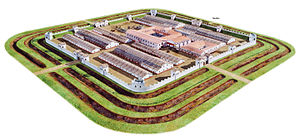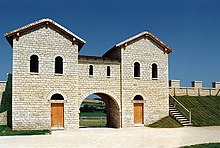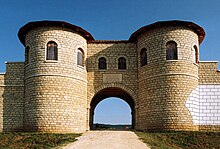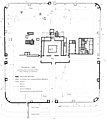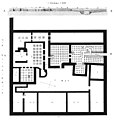Weissenburg Castle
| Weissenburg Castle | |
|---|---|
| Alternative name | Biriciana |
| limes | ORL 72 ( RLK ) |
| Route (RLK) | Rhaetian Limes, route 14 |
| Dating (occupancy) | around 90 AD to around 253 AD |
| Type | Alenkastell |
| unit | Ala I Hispanorum Auriana |
| size | a) approx. 2.8 ha b) 3.1 ha |
| Construction | a) wood-earth b) stone |
| State of preservation | Parts of the enclosure were partially bricked up and visibly conserved, the north gate was reconstructed, the underground buildings are indicated on the ground by stone markings. |
| place | Weißenburg in Bavaria |
| Geographical location | 49 ° 1 ′ 51 ″ N , 10 ° 57 ′ 45 ″ E |
| height | 415 m above sea level NHN |
| Previous | ORL 71a Kastell Theilenhofen (west) , Kastell Ellingen (north) |
| Subsequently |
Wood-earth fort in Weißenburg (northeast) Oberhochstatt fort (east) Burgus Burgsalach (east) |
| Backwards |
Fort Munningen (west-southwest) Fort Faimingen (south-west) Fort Pfünz (south-east) |
| Upstream | Small fort Gündersbach (north) |
The Castle White Castle , in ancient Biriciana called was, Roman Alen - fort that close to the Upper Germanic-Rhaetian Limes , a World Heritage Site built, was, and in the city of White Castle in the Middle Franconian district of Weissenburg-Gunzenhausen is. Today the fort, with its remains of buildings, some of which have been preserved underground, the reconstructed north gate, the large thermal baths and the Roman museum with integrated Limes information center, is one of the most important addresses for Limes research in Germany .
location
The Weißenburg fort is located in the “Kesselfeld” corridor on the western edge of the city on a free area that has been designated as an archaeological protection zone. The garrison town was founded on a clear bump in the ground that slopes gently to the northwest, towards the Swabian Rezat . With its praetorial front and the main gate, the Porta praetoria , the fortification is oriented towards the southeast, while the north-facing, rear Porta decumana faces the Rhaetian Limes , which runs around five and a half kilometers to the north . From the elevated location, the Roman occupation had a strategically favorable all-round view.
Research history
The Roman name Biriciana has been passed down through the Tabula Peutingeriana , the medieval copy of a late antique road map, but the exact location of the place remained uncertain until the early 19th century. The historian Andreas Buchner (1776-1854) was in 1818 the first in his report Voyage of the devil-wall spoke for White Castle, but he believed mistakenly east of White Castle located in the 2.5 km Postal Old Bürg the castle to detect. This observation persisted for decades. During the reign of King Maximilian II (1848–1864), a memorial stone for the Castrum was erected on the west end of the Bürg .
In February 1868, the Weißenburg military diploma of June 30, 107, which was often cited in the following years, was found during the construction of the station. In the vicinity of the "Kesselfeld" corridor to the northwest of the station, initially only a Roman civil settlement was assumed. It was the archeology pioneer Friedrich Ohlenschlager (1840–1916) who, after theoretical considerations, considered this place the right location for the garrison in 1884. Phonologically, the name "Kesselfeld" can be traced back to the ancient word Castellum . However, Ohlenschlager's own digs did not produce any clear results. Archaeological evidence of an auxiliary fort was therefore only provided by the pharmacist Wilhelm Kohl (1848–1898), who was enthusiastic about antiquity and who in 1890 led an excavation by the Weissenburg Antiquities Association founded in 1889. Until his death, Kohl carried on the investigations as route commissioner of the Reichs-Limeskommission (RLK) active from 1891 . In 1898 all the main stone buildings of the complex were known. His successors, the Kommerzienräte Julius Tröltsch (1841-1910) and Max Raab (1860-1946), carried on the actual excavations of the Reich Limes Commission until 1913. In 1914 Raab succeeded in protecting the fort area from overbuilding in the long term by taking the lead in promoting the purchase of the site by the administrative district. He then carried out additional examinations in the camp area until 1917. This ended the period of the most important archaeological excavations to date at the Biriciana garrison site.
As the most important excavation of the interwar period, a smaller bath west of the fort was partially examined in 1926. It was on the fortification road there. Especially after the Second World War , there were often sensational discoveries in and around Weißenburg, most of which the Bavarian State Office for Monument Preservation played a leading role. The foundations of the fort buildings, which had been exposed until then, were filled in again in 1965 after none of the known conservation methods had proven successful. However, in order to make the floor plans of the stone buildings more visible to the public, concrete was applied to the top of the wall in 1963/1964.
In 1976, around 1.6 kilometers from the fort, on the northeastern outskirts of Weißenburg in the "Breit" corridor, a wood-earth store was discovered with the help of aerial archeology , which was opened up in several excavation campaigns until 1991. Around 1.7 kilometers southeast of the Biriciana garrison, the partial ground plan of another fort near Emetzheim , located in the "Steinmaueräcker" corridor , became known in the summer of 1977 . As early as March of the same year, during the construction of a settlement, the largest Rhaetian thermal baths in a camp village (vicus) to date had been discovered. Due to its importance and the good state of preservation, this bath was provided with a temporary roof structure in 1983, completely restored by 1985 and finally secured for posterity by an elaborate protective structure. The treasure trove of Weißenburg , which came to light during gardening not far from the thermal baths in autumn 1979, became an archaeological sensation . In 1986/87, subsequent excavations on the northern front of the stone fort succeeded for the first time in providing reliable evidence of the existence of a wood-earth store as the previous building. In 1989/90 a reconstruction of the Porta decumana was made on the original foundations , which according to today's knowledge should have been one floor higher. In the archaeological park founded in 1990, which extends over the entire fort area, the contours of the defensive walls and the principia have been preserved. In 2006 a magnetometer measurement took place on the fort area, which for the first time since the camp plan published in 1906 yielded partly new, sometimes deviating results.
The Weißenburg Roman Treasure, the most important southern German find of its kind, became the focus of the Weißenburg Roman Museum , a branch of the State Archaeological Collection, which was built in 1981 after it was purchased by the State of Bavaria . In connection with the recognition of the Upper German-Raetian Limes as a World Heritage Site in 2005, Weißenburg was chosen as the location of the Bavarian Limes Information Center, integrated into the Roman Museum Weissenburg and opened in May 2006.
Building history
In the Domitian or probably early Trajan period, probably around the year 100, a first 2.8 hectare wood and earth fort was built at a strategically important location. The garrison served there to secure the newly conquered territory north of the Danube, which had been incorporated into the province of Raetia . As the excavations carried out in 1986 revealed, the porta decumana of the wood-earth store on the north front consisted of twelve posts, six of which belonged to one of the two gate towers that flanked the actual gate. The two wooden rectangular towers had a 3.20 x 3.60 meter floor plan. A palisade ditch around 0.60 meters wide connected the gate on both sides with the adjoining intermediate towers, each supported by four posts.
Around the middle of the 2nd century the wood and earth fort was replaced by a stone fort of 3.1 hectares in size. The new stone enclosure wall with its gates and towers was erected directly in front of the older wooden fort. Probably around 253 or 254 at the latest, the fort and vicus were destroyed in the course of the Alemannic invasions ( Limes Falls ). The final coins from a coin treasure find on the Via principalis dextra date back to 251 and 253.
Biriciana in its last expansion phase was a stone fort for an ala, almost square with dimensions of 170 by 174 by 179 meters. The fort wall was rounded at the corners and provided with defense towers. The total of four gates were flanked by twin towers, between these and the corner towers there was another, smaller tower.
The wall itself was surrounded by a double moat, a further moat could so far only be verified on three sides of the fort. This pit system was only interrupted in the area of the camp gates. On the northern front, during the archaeological excavations in 1986, the trench was cut again. It was found that the outermost pointed trench was 2.70 meters wide and 1.60 meters deep. The middle trench was measured with a width of 4.50 meters and a depth of 1.40 meters. As a special feature, this trench was created as the Fossa Punica . The enemy-facing side was sunk vertically into the ground, while the side facing the surrounding wall was sloping. The innermost trench was the widest at 5.40 meters.
The Weißenburg Fort is facing south with its Porta praetoria (main gate), while the smaller Porta decumana faces the Limes. Porta principalis dextra (right side gate) and Porta principalis sinistra (left side gate) correspond in their size to the Porta praetoria .
The administration and supply buildings were all made of stone and were located in the central part of the camp, the center of which was formed by the large principia (staff building) with the flag sanctuary (Aedes) and a basilica in front of it . Not far from there were the Horreum (granary) , which was raised to protect against small animals, and the commandant's residential building (Praetorium) . In the western storage area were the Fabricae (workshops) and the Valetudinarium (military hospital). In contrast to these buildings, the accommodations for teams and animals consisted of half-timbered buildings . The team barracks with the contubernia (communal rooms) were in the Retentura (rear, northern part of the camp), the stables in the Praetentura (front, southern part of the camp).
The remains of a tank statue, as it could once have been placed in the flag shrine in the Principia , come from the fort area . These fragments date to the first half of the 3rd century AD.
- Findings at the time of the Reich Limes Commission (1890 to 1905)
Troops and officers
Both the names of the two units located in Weißenburg and the names of some officers and their ranks have been preserved through inscriptions. A votive altar for Jupiter , which was walled up at St. Andrew's Church until 1892, names a Marcus Victorius Provincialis as the troop commander ( Praefectus cohortis ) of the Cohors IX Batavorum equitata milliaria exploratorum .
- I (ovi) o (ptimo) m (aximo)
- sacrum
- coh (ors) IX Bat (avorum)
- eq (uitata) (miliaria) expl (oratorum)
- cui praeest
- M (arcus) Victorius
- Provincia
- lis praef (ectus)
- v (otum) s (olvit) l (ibens) l (aetus) m (erito)
Translation:
Jupiter, dedicated to the best and greatest. The 9 Batavian partially mounted 1000-strong reconnaissance cohort, commanded by commander Marcus Victorius Provincialis, has happily, joyfully and paid for, redeemed its vows.
The wealthy Decurio (Captain) Primus Saturninus the Ala I Hispanorum Auriana (first cavalry unit of the Spanish "Auriana") settled after his honorable discharge from the military in the late 2nd century. Chr. In Celeusum down, which is a by Fund position must also have been an important place on the Limes. His 1.22 x 0.5 meter inscription, which once belonged to a corresponding monument, was found during the renovation of the Pförring parish church in 1903 and can now be found on the Sebastian Chapel there:
- Prim (us) Saturninus
- ex dec (urione) al (ae) Auri (anae) m (issus) h (onesta) m (issione)
- Iul (iae) Victorinae uxo (ri)
- Prim (ae) Saturninae / [---
Translation:
Primus Saturninus, former honorably discharged Rittmeister of the Ala Auriana, has his wife Julia Victorina ...
The gravestone of a team soldier, formerly also to be found at the Weissenburg Andreaskirche, names another decurion named Martinus:
- D (is) M (anibus) Victor (is)
- cura [gentis]
- ex t (urma)
- Martini
The Optio equitum , sergeant in command of the Ala Auriana , Flavius Raeticus, is mentioned in a dedicatory inscription from the year 153 AD. She was found in nearby Emetzheim :
- Pro salu [te an]
- tonini imp (eratoris) n (ostri)
- Mercurio sa (crum) Fl (avius) Rae
- ticus optio
- eq (uitum) al (ae) Aur (ianae)
- v (otum) s (olvit) l (ibens) l (aetus) m (erito)
- Pr [ae] sente et [Ruf] ino co (n) s (ulibus)
Translation:
For the good of our emperor Antoninus. Flavius Raeticus, Optio equitum of the Ala Auriana, was happy to redeem his vows for holy Mercury, joyfully and for a fee. Under the consulate of Praesens and Rufinus.
The fort was occupied by the Ala I Hispanorum Auriana (1st Spanish Cavalry Unit Auriana) except for a small interruption . The Alae (in German: wings ) were independently operating cavalry units with both tactical and strategic functions , consisting of 16 towers (departments) of around 30 to 33 riders each .
The Cohors IX Batavorum equitata milliaria exploratorum , which has also been attested, could possibly be assigned to the second wood-earth store in the east in the " Breiten " corridor . This complex was probably built shortly after the middle of the second century. Maybe it replaced in the Parthians - and Marcomannic wars abkommandierte Ala I Hispanorum .
In the winter of 1867, during construction work on the Treuchtlingen - Pleinfeld railway line , a military diploma dated June 30, 107 was recovered for the soldier Mogetissa . The Boier Mogetissa, son of Comatullus, also belonged to the Ala I Hispanorum Auriana . With his release certificate he was able to marry his partner Verecunda and legitimize their daughter Matrulla. The commanding officer of the Ala was then Marcus Insteius Coelenus, son of Marcus, from the tribe of Palatina .
Well-known commanders of the Ala I Hispanorum
| Surname | rank | Time position | comment |
| Marcus Insteius Coelenus | June 30, 107 | Son of Marcus, from the tribe of Palatina | |
| [...] Bassus Roma | 122-140 | ||
| Sextus Graesius Severus Piceno | September 28, 157 |
Vicus, thermal baths and the surrounding area

Usually, in the immediate vicinity of Roman garrisons, family members of the soldiers, soldiers after their service time, traders, craftsmen and pubs also settled in the civil settlements called Vici , including in Weissenburg. The vicus of Biriciana , the exact demarcation of which could no longer be localized everywhere due to the modern development, extended over a total area of about 30 hectares and at its heyday in the late second century should have reached a population of around 2,500.
The extensive Weißenburg Vicus included a mansio and three bathing buildings, of which the so-called " Great Baths " are among the most remarkable buildings of this type on German soil. A total of three construction phases could be identified for this bath complex. The first building was built at the same time as the fort was erected around the year 90 and was a simple row bath, which was significantly expanded by 130 in a second construction phase. After the bath house probably due to the Marcomanni wars had been destroyed, was built around the year 180, a third with the dimensions of 65 times 42.5 meters significantly larger and more luxurious spa resort from the ring type. This lasted until it was severely damaged in the course of the Alemanni raids around the year 230 . After that, only individual remaining rooms were used for other than bathing purposes.
One by aerial prospecting localized Villa Rustica , two and a half kilometers south of the fort, west of the after Treuchtlingen leading road was excavated in 1985/86. It was a rather modest property with six rooms and a walled courtyard area of 240 square meters.
Monument protection
The Weißenburg Fort and the facilities mentioned have been part of the UNESCO World Heritage as a section of the Upper Germanic-Rhaetian Limes since 2005 . In addition, they are protected as registered ground monuments within the meaning of the Bavarian Monument Protection Act (BayDSchG) . Investigations and targeted collection of finds are subject to authorization, accidental finds must be reported to the monument authorities.
See also
- List of forts on the Upper German-Raetian Limes
- Roman thermal baths (Weißenburg)
- Weissenburg Roman Museum
literature
- Dietwulf Baatz : The Roman Limes. Archaeological excursions between the Rhine and the Danube. 4th edition. Gebr. Mann, Berlin 2000, ISBN 3-7861-2347-0 , p. 289 ff.
- Wilhelm von Christ : The Roman military diploma from Weissenburg. Franz, Munich 1868.
- Wolfgang Czysz among others: The Romans in Bavaria. Nikol, Hamburg 2005, ISBN 3-937872-11-6 .
- Thomas Fischer and Günter Ulbert : The Limes in Bavaria. From Dinkelsbühl to Eining . Theiss, Stuttgart 1983, ISBN 3-8062-0351-2 .
- Ernst Fabricius, Felix Hettner and Oscar von Sarwey (ed.): The Upper Germanic-Raetian Limes of the Roman Empire. Dept. A, Vol. 7, Route 14: The Raetian Limes from Gunzenhausen to Kipfenberg. Berlin 1927.
- Eveline Grönke: New excavations in the Biriciana stone fort. City of Weißenburg i. Bay., Weissenburg-Gunzenhausen district, Middle Franconia . In: The archaeological year in Bavaria 1986 (1987), pp. 116–118.
- Eveline Grönke: The Roman Alenkastell Biricianae in Weißenburg in Bavaria. The excavations from 1890 to 1990. (Limes research, vol. 25). Zabern, Mainz 1997, ISBN 3-8053-2318-2 .
- Eveline Grönke, Edgar Weinlich: The northern front of the Roman fort Biriciana-Weissenburg: The excavations 1986/1987. Prehistoric State Collection Munich, Laßleben, Kallmünz 1991. ISBN 3-7847-5125-3 .
- Ute Jäger: Roman Weissenburg. Biriciana castle, large thermal baths, Roman museum . Keller, Treuchtlingen / Berlin 2006, ISBN 3-934145-40-X .
- Hans-Jörg Kellner : The Roman treasure find from Weißenburg . 3rd expanded edition. Schnell & Steiner, Regensburg 1997, ISBN 3-7954-1104-1 .
- Hans-Jörg Kellner, Gisela Zahlhaas, with contributions by Hans-Gert Bachmann, Claus-Michael Hüssen, Harald Koschik, Zsolt Visy and Ulrich Zwicker: The Roman temple treasure of Weissenburg i. Bay. , von Zabern, Mainz 1993, ISBN 3-8053-1513-9 .
- Martin Pietsch, Jörg Faßbinder , Ludwig Fuchs: More depth of field through magnetics: The new plan of the Weissenburg Castle. In: The Archaeological Year in Bavaria 2006. Stuttgart 2007, pp. 98–101.
- W. Kohl, J. Tröltsch, J. Jacobs, W. Barthel and Ernst Fabricius : The Upper Germanic-Raetian Limes of the Roemerreich . Dept. B, Vol. 7, No. 72: Weissenburg Castle. Berlin 1906.
- Johann Schrenk and Werner Mühlhäußer: Land on the Limes. In the footsteps of the Romans in the Hesselberg - Gunzenhausen - Weißenburg region . Schrenk, Gunzenhausen 2009, ISBN 978-3-924270-57-5 , in particular pp. 107-114.
- Simon Sulk: Biriciana Roman fort. Weißenburg in Bavaria . Verlag Pustet Regensburg, Regensburg 2020, ISBN 978-3-7917-3158-2 .
- Ludwig Wamser: Biriciana - Weißenburg in Roman times . 2nd edition. Theiss, Stuttgart 1986. (Guide to archaeological monuments in Bavaria: Franconia 1), ISBN 3-8062-0323-7 .
Web links
| 3D reconstruction of the Weissenburg Castle |
|---|
| ArcTron 3D , 2013 |
| Multimedia production power, splendor and decline - Roman Weissenburg. |
|
Link to the picture |
- Weißenburg Fort on the website of the German Limes Commission (accessed on December 3, 2015)
- Biriciana on the private project page about antiquity by Bernd Liermann (accessed December 3, 2015)
Remarks
- ↑ Andreas Buchner: Journey on the Devil's Wall Monday-Weissische Verlagsbuchhandlung, Regensburg 1818. P. 20; Ludwig Wamser: Biriciana - Weißenburg in Roman times. Theiss, Stuttgart 1984. ISBN 3-8062-0323-7 . P. 15.
- ↑ Ludwig Wamser: Biriciana - Weißenburg in Roman times. Theiss, Stuttgart 1984. ISBN 3-8062-0323-7 . P. 14.
- ↑ CIL 16, 55 .
- ^ A b Ludwig Wamser: Biriciana - Weißenburg in Roman times. Theiss, Stuttgart 1984. ISBN 3-8062-0323-7 . P. 18.
- ↑ Ludwig Wamser: Biriciana - Weißenburg in Roman times. Theiss, Stuttgart 1984. ISBN 3-8062-0323-7 . P. 26.
- ↑ Ludwig Wamser: Biriciana - Weißenburg in Roman times. Theiss, Stuttgart 1984. ISBN 3-8062-0323-7 . P. 19.
- ↑ a b c Eveline Grönke: New excavations in the Biriciana stone fort. City of Weißenburg i. Bay., Weissenburg-Gunzenhausen district, Middle Franconia . In: The archaeological year in Bavaria 1986 (1987), pp. 116–118; here: p. 118.
- ↑ Ludwig Wamser: Biriciana - Weißenburg in Roman times. Theiss, Stuttgart 1984. ISBN 3-8062-0323-7 . P. 28.
- ↑ Ludwig Wamser: Biriciana - Weißenburg in Roman times. Theiss, Stuttgart 1984. ISBN 3-8062-0323-7 . P. 29.
- ^ Jochen Garbsch : Weißenburg / Biriciana . In: Walter Sölter (Ed.): The Roman Germania from the air . 2nd Edition. Lübbe, Bergisch Gladbach 1983, ISBN 3-7857-0298-1 , p. 39.
- ^ Jochen Garbsch : Weißenburg / Biriciana . In: Walter Sölter (Ed.): The Roman Germania from the air . 2nd Edition. Lübbe, Bergisch Gladbach 1983, ISBN 3-7857-0298-1 , p. 40.
- ^ Martin Pietsch, Jörg Fassbinder , Ludwig Fuchs: More depth of field through magnetics: The new plan of the Weissenburg Castle. In: The Archaeological Year in Bavaria 2006. Stuttgart 2007, pp. 98-101; here: p. 98.
- ^ Limes information center in Weißenburg
- ↑ Martin Kemkes : The image of the emperor on the border - A new large bronze fragment from the Raetian Limes . In: Andreas Thiel (Ed.): Research on the function of the Limes , volume 2. Konrad Theiss Verlag, Stuttgart 2007, ISBN 978-3-8062-2117-6 , p. 144.
- ↑ CIL 03, 11918
- ^ Konrad Kraft : On the recruitment of ales and cohorts on the Rhine and Danube , Francke, Bern 1951. p. 75.
- ↑ CIL 03, 05925
- ↑ CIL 03, 05924
- ↑ C.-M. Hüssen, Weißenburg - on the spread. In: S. Matesic, CS Sommer (Ed.), At the Edge of the Roman Empire. Contributions to the Limes World Heritage. Special volume 3 (Mainz 2015) 122–123.
- ↑ CIL 16,00055 .
- ↑ CIL 16, 00105 .
- ↑ Dan Dana: Les Thraces dans les militaires diplômes: Onomastique et statut des personnes . In: Maria-Gabriella G. Parissaki (ed.): Thrakika Zetemata II: Aspects of the Roman province of Thrace Athens 2013, ISBN 978-960-9538-18-3 , pp. 219-269; here: p. 229.
- ↑ Detailed presentation with extensive photographic documentation of the "Great Thermal Baths" ( memento from February 2, 2007 in the Internet Archive ) by Bernd Liermann.
- ↑ Row bathroom = simple linear arrangement of the bathrooms.
- ↑ Ring type = thermal baths to be used in a circular manner by doubling the rooms.


